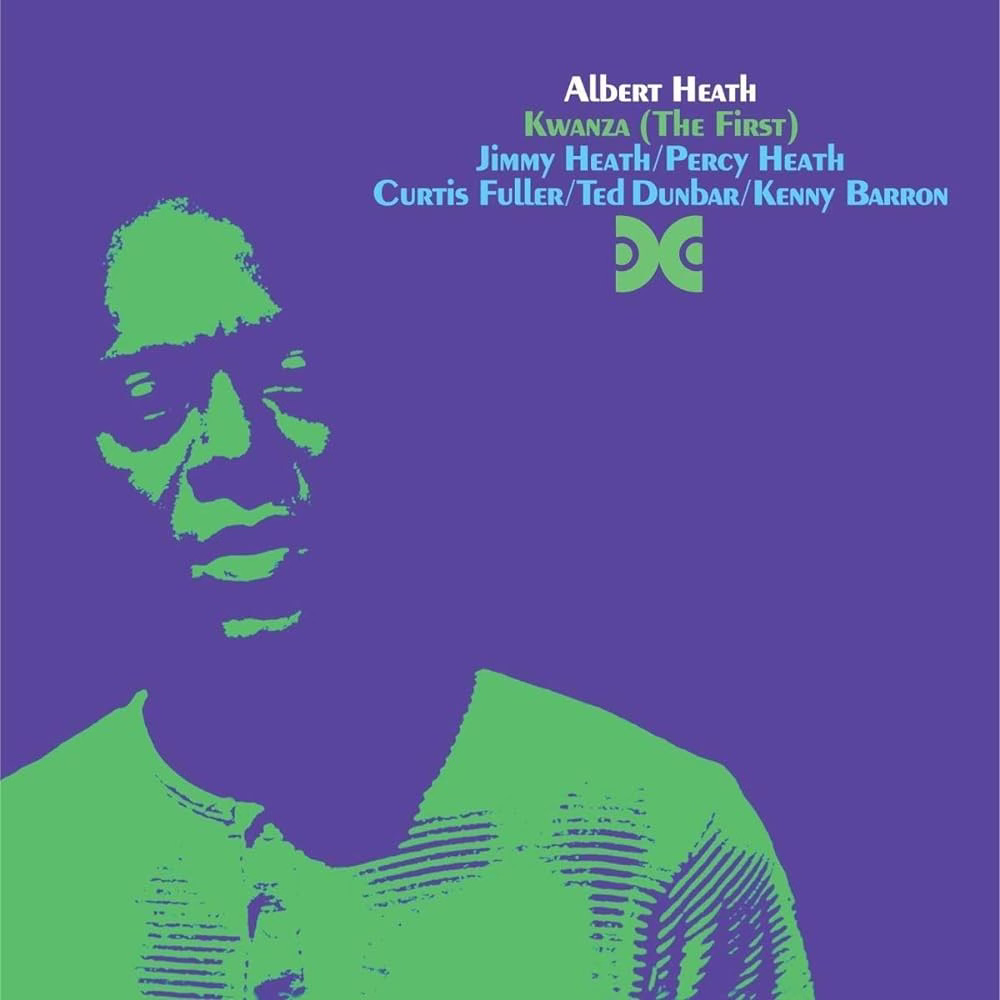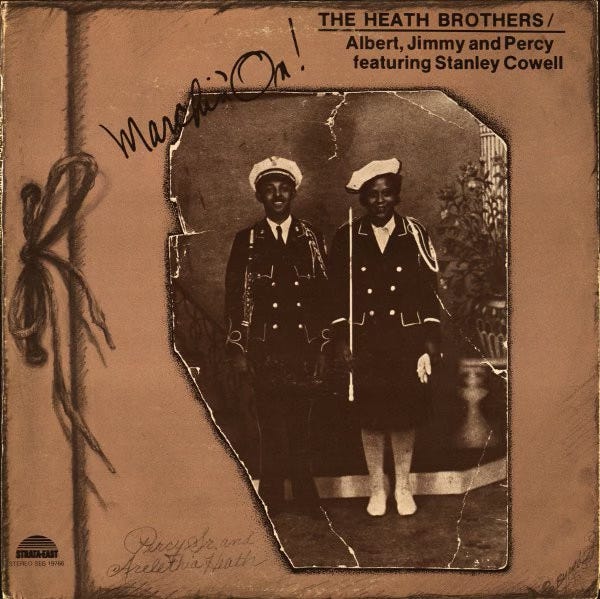Further Tootie
Albert "Tootie" Heath playing backbeats, flute, musette, and an epic "Four" with Sonny Rollins.
….Drummers have a big responsibility to be happy…..
-Albert “Tootie” Heath
Drummer Albert “Tootie” Heath, who died on April 4th, was one of the greatest jazz drummers of all time; I touched on what made him so great here.
I’ll treasure the nights listening to him at the Vanguard with his brother tenor saxophonist Jimmy Heath, or in the trio he led with Ethan Iverson and Ben Street. But there’s so much more where that came from.
This is my second article on him in the wake of his passing. Here, I’m Chronicling my trip further down a Tootie rabbit hole. As I suspected, there are treasures:
Sonny Rollins, “Four”, recorded September 6, 1968, Cafe Montmartre, Copenhagen Denmark.
Rollins was in Europe for much of the fall of 1968. Part of that tour was a visit to the legendary Copenhagen jazz club, where he played with the house rhythm section of pianist Kenny Drew, bassist Niels-Henning Orsted Pedersen, and Albert “Tootie” Heath.
Two sets were recorded. It’s all invaluable music, but the standout is a 45-minute version of “Four”. (Full disclosure— I heard this in my twenties but didn’t realize until years later that it was Tootie on drums; it wasn’t until this week I learned that it was recorded at Cafe Montmartre.) This “Four” is one of the great performances in jazz, made possible by Tootie Heath.
Drew and Pedersen sound great of course, but “Four” is all about Sonny with Tootie. Heath’s genius here is that he never peaks, never boils over, never explodes, neither does he come down, get creative, and build back up. He’s just a straight line of intensity and invention, not encroaching onto Sonny’s turf, yet able to match Rollins’ stamina and spontaneity.
On the surface, Heath is playing straight-ahead jazz drums— time on the ride cymbal and accents on the bass and snare. But the colossal length of “Four” complicates matters, and exposes what made Heath so special. Only a sensitive, empathetic, imaginative drummer, with an open mind and heart, and complete technical mastery, could light a fire hot enough to sustain Sonny and the band for so long.
Tootie is selflessly supporting Rollins’s journey to the outer limits, while also rising to Sonny’s challenge of endurance and invention. It’s just chorus after chorus of relentless forward motion— behind Sonny, Kenny Drew, NHOP, and then trading fours— that somehow never becomes dull or repetitive; it’s just little peaks, tiny valleys, up and down the incline, for 45 minutes. This is what jazz drumming is all about.
I hope “Four” and the rest of the ‘68 Montmartre tapes sees official release from the Rollins estate someday. This is extraordinary stuff. I’m listening to “Four” as I write this in Berlin after a typical no-sleep overseas flight; Sonny and Tootie are so strong I feel ready to run a 15K.
Yusef Lateef: “Nubian Lady” from The Gentle Giant (Atlantic, recorded 1972).
Tootie was a member of Lateef’s quartet, which also featured Kenny Barron and bassist Bob Cunningham, from 1972 to 1975. This track stands out for Tootie’s infectious beat, sixteenths on the hi hat with his right hand on a kit perfectly tuned for backbeat music. I’m sure hip-hop producers have made use of this track for decades.
Albert Heath: Kwanza (The First) (Muse, New York, June 4, 1973)
Tootie’s found a way for the backbeat, open improvisation, and bebop wisdom to coexist. And, Tootie’s a composer— all but two of the six tunes on Kwanza are Tootie compositions! I didn’t know this, I’d never heard any of these songs. I am learning.
Both Jimmy and Percy Heath are on Kwanza, and it’s striking to hear how easily they get with Tootie’s disparate styles. Tootie’s own “Tafadhali” is some infectious soul music, while “Dr. JEH” features an unconventional form, some bars of 3/4, and Heath in his high-modernist zone.
Clifford Jordan: Half Note (Steeplechase, New York, April 5, 1974). Clifford Jordan, Cedar Walton, Sam Jones, Tootie.
A lo-fi, high-content gig at the Half Note, with some explosive Tootie; his intros and solos on “St. Thomas” and “Rhythm-A-Ning”suggest Ralph Peterson, Jeff “Tain” Watts, and Tony Williams. Heath puts the right amount of spin and intensity on the beat on Walton’s “Holy Land” and Jordan’s “Glass Bead Game”. Interesting to hear Tootie in what was clearly Billy Higgins’s chair. Comparatively, Tootie’s beat and sound were just a smidge heavier and thicker.
Dexter Gordon: The Apartment (Steeplechase, recorded in Copenhagen, Denmark, May 24 1974). Dexter, Kenny Drew, piano; NHOP, bass; Tootie.
Every phrase Dexter Gordon played is infused with soul, intelligence, and good humor. If the rhythm section behind Dexter is fully synced, they can create endless variety on the most basic material. Hence, The Apartment, what must be the best bebop album of 1974.
Tootie, on a thuddy studio kit tuned for backbeat music, weaves a perfect modern jazz tapestry on “The Apartment”, swings out elegantly on Horace Silver’s “Strollin”, and veers close to Tony Williams on “Stablemates”, at times playing four quarter notes on the hi hat. Dexter’s inspired, the old Cafe Montmartre trio is back together. This is a great record.
The Heath Brothers: Marchin’ On (Strata-East, recorded October 1975)
The first release credited to the Heath Brothers is ECM-adjacent— it was engineered by ECM’s Jan Erik Kongshaug, recorded in Oslo, and seems of a piece with other early ECM classics like Bennie Maupin’s The Jewel In The Lotus and Marion Brown’s Afternoon Of A Georgia Faun.
Like those records, Marchin’ On is astonishing in its breadth and scope— Ellingtonia, flute choirs, African instruments, backbeats and bebop. It’s all here. It’s streaming on YouTube, but we badly need a Strata-East reissue program.
Ellington’s “Warm Valley” is played by a quartet of Jimmy on flute, Percy on bowed bass, Stanley Cowell on kalimba, and Tootie playing the melody on flute! Tootie’s own “Tafadhali” (also heard on Kwanza) keeps the flute duo of Tootie and Jimmy, while “The Watergate Blues” features Percy on an acoustic baby bass, sounding an awful lot like an acoustic guitar; there’s a real back-porch flavor to this. Jazz is folk music after all.
Side 2 is devoted to the “Smilin Billy” suite composed by Jimmy, with backbeat, vamps, a brief free drum solo, and at 30:25, Tootie featured on an ‘African double reed instrument’ (as per the album liners) that sounds like Dewey Redman’s musette.
It’s easy to connect Marchin On to the movement which brought Archie Shepp, the Art Ensemble of Chicago, and Philly Joe Jones together five years earlier. Like those records, Marchin On was made in Europe and touches on the whole range of Black music, giving us a look at Albert Heath’s complete musicianship. This was what I was hearing and responding to when Tootie was at the Vanguard. That cymbal beat of Tootie’s contained untold depths.






Wonderful pair of articles about a fascinating drummer who managed to remain "contemporary" for much of his career. I once saw Tootie backing Pharoah Sanders (with Kirk Lightsey, Tony Dumas, and Babatunde Lea also on board) and he blew the roof off the Lighthouse (or maybe it was Concerts By The Sea — I forget which). This was in the late 70's. Back then I was playing a bit of drums and idolized Eric Gravatt, who positioned his ride sky high and vertical, playing with his head leaning on his outstretched right arm. Tootie had TWO cymbals positioned super high but horizontal — I honestly couldn't understand how he was hitting them, it was like a circus act. By the way, you might consider adding something from "Kawaida" to your YouTube playlist. That was of course a de facto Mtume album credited to Tootie, but it's a fascinating session with Ed Blackwell playing a second set of traps on some tracks, and Don Cherry playing alongside Jimmy Heath and Herbie Hancock.
Thanks for that. Some things I’m looking forward to investigating. Harold Land’s Mapenzi has excellent Albert Heath too.